Florida’s Consumer Foot Traffic Recovering in Some Categories
July 20, 2022

Florida is a big vacation destination, but the Sunshine state isn’t just for vacationers. Many people moved to Florida in the wake of the coronavirus pandemic. Even as recently as last year, Florida continued to see an increase in people from other states relocating there. Early on during the pandemic, Florida remained open and had some of the less restrictive coronavirus guidelines in the country. With coronavirus cases easing, Florida’s tourist economy is once again thriving. Is the return of tourism also giving Florida’s consumer foot traffic a boost? Does it reflect Florida’s consumer sentiment? To answer these questions, we analyzed consumer foot traffic to select place categories (e.g. Shopping, Entertainment, etc.) to see which sectors of Florida’s economy are booming (and which ones aren’t). We also look at major cities to see if their consumer foot traffic trends are similar to the state’s patterns.

Which categories are outperforming others in Florida? Overall, the categories of Outdoors & Recreation, Entertainment – General, and Shopping outperformed other categories in terms of foot traffic. Besides its warm weather, Florida is known for its beaches and parks, which could explain why consumer foot traffic to outdoor destinations was 32% higher year over year. Florida is also home to popular theme parks like Walt Disney World and Universal Studios; foot traffic to general entertainment venues was 26% higher in May 2022, compared to May 2021. The category of Shopping was below May 2021 foot traffic levels during the winter months, but saw an increase in traffic starting in March 2022. By May 2022, retail foot traffic was 17% higher than in May 2021. Florida’s tourism industry could have helped these categories thrive, especially during Spring Break and other months with holidays.
The Automobile category didn’t perform as well as the others; consumer foot traffic was 12% lower to auto-related businesses. Given that the best transportation to get around Florida’s sunny coasts is by car, it is surprising to see that consumers aren’t visiting auto shops and dealerships. Another category which underperformed was Accommodations. Hotel foot traffic in May 2022 was 3% lower, compared to the same month of the previous year.

Accommodations
Most major cities in Florida saw foot traffic to accommodations, like hotels and destination resorts, above May 2021 levels during the summer of 2021, but traffic decreased significantly after August 2021. However, foot traffic to accommodations increased dramatically after February 2022 and into the months leading up to spring break. By May 2022, hotel foot traffic in Orlando was 26% higher, compared to the same period last year. Miami was close behind Orlando; May 2022 foot traffic to accommodations in Miami was 24% higher than in May 2021. Interestingly, hotel foot traffic in Tampa was 15% lower than in May 2021. Jacksonville’s hotel foot traffic during May 2022 remained flat.
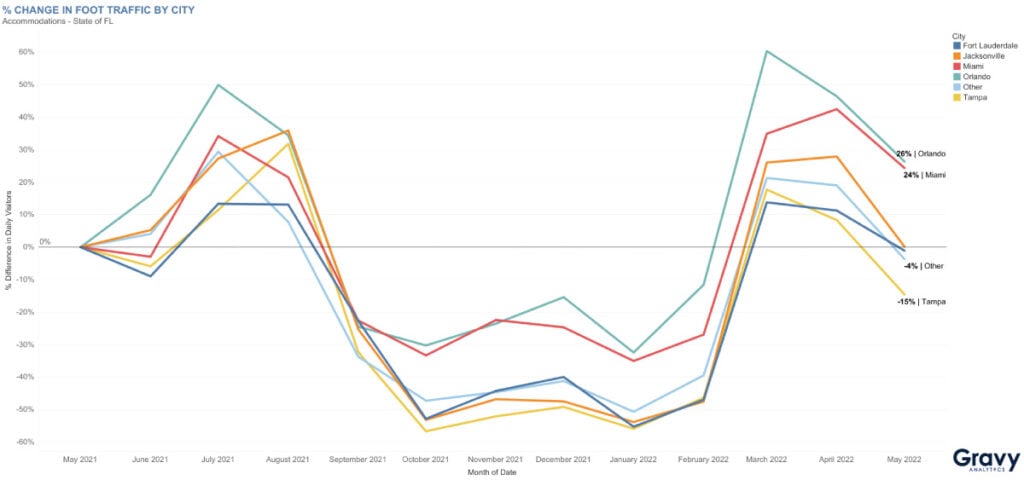
Automobile
Foot traffic to auto-related businesses in most Florida cities peaked in July 2021, except for Fort Lauderdale. After July 2021, foot traffic declined and remained below May 2021 levels. After February 2022, foot traffic to auto businesses increased significantly, but largely remained below May 2021 levels. Only Miami and Jacksonville saw slightly higher foot traffic in April 2022, which could be attributed to car rentals around Spring Break. Foot traffic to Miami and Jacksonville was only 4% and 7%, respectively, compared to May 2021.
Unlike Miami and other cities we analyzed, Orlando’s automobile-related foot traffic was 17% lower year-over-year. A study by iSeeCars found several Florida metro areas, including Orlando-Daytona Beach, Miami-Ft. Lauderdale, and Jacksonville, saw large increases in used car prices. High car price tags along with the soaring cost of gas is more than likely deterring consumers from purchasing new and used cars, and causing people to focus on car maintenance and upkeep.
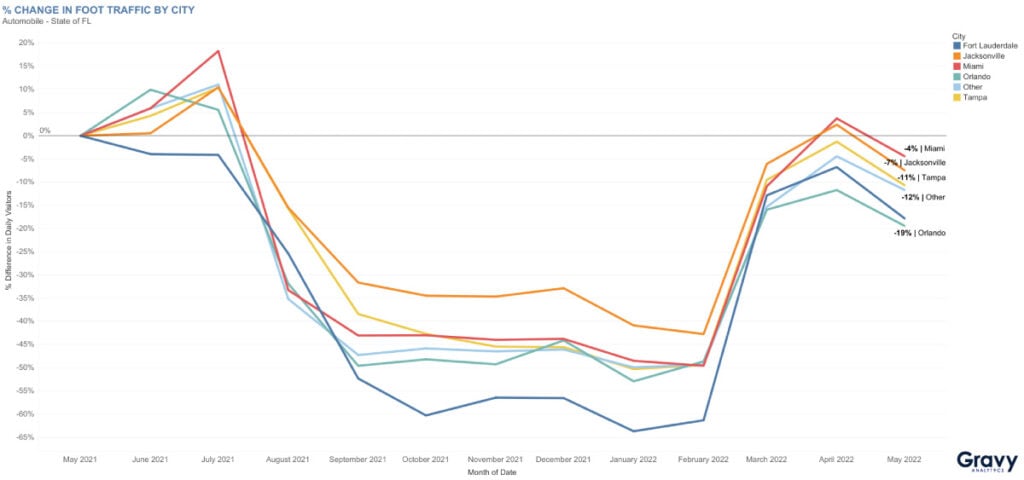
Entertainment
Most Central Florida cities like Tampa and Jacksonville saw peaks in entertainment-related foot traffic during July 2021. After July 2021, foot traffic declined and then increased again above May 2021 levels. By May 2022, Tampa’s consumer foot traffic was 77% higher than in May 2021, while Jacksonville’s foot traffic saw a 58% increase. Other cities within Florida saw a 45% increase in foot traffic to entertainment businesses. However, Orlando’s foot traffic didn’t recover after its peak in June 2021. By May 2022, foot traffic to Orlando entertainment venues was 37% lower, compared to May 2021. A COVID surge in the later summer may have caused many event planners to cancel or postpone conferences in Orlando, which is known as a popular site for meetings.
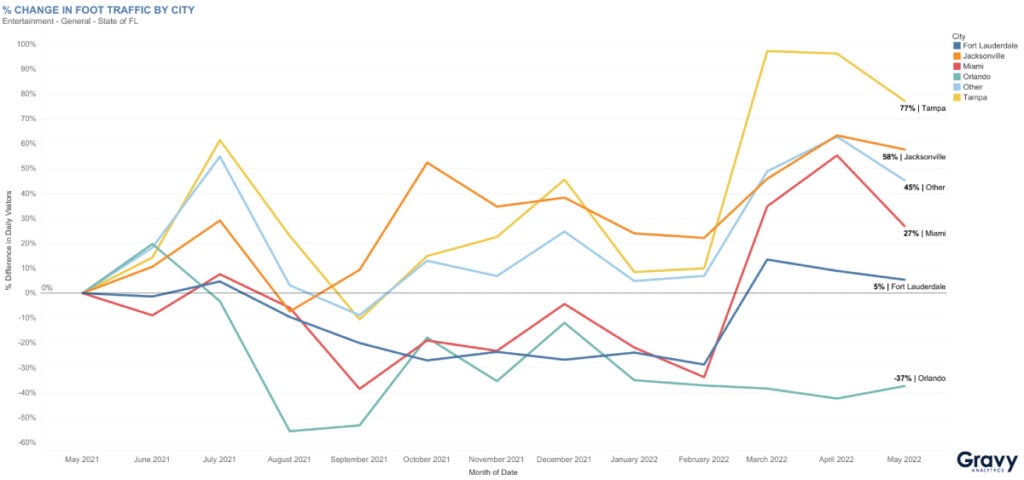
Outdoors & Recreation
Throughout 2021, foot traffic to outdoor and recreation venues in most Florida cities remained above May 2021 levels. Disney World and other well-known tourist destinations like Universal Studios are extremely popular in Florida. This could possibly explain why Orlando, the home of Disney and Universal Studios, saw a 59% increase in visits to outdoor locations year over year. In May 2022, Jacksonville was right behind Orlando; its foot traffic was 52% higher, compared to May 2021. Both locals and tourists alike can participate in a variety of outdoor activities at Jacksonville’s parks and beaches.
Surprisingly, Miami and Tampa, known for their nightlife, weren’t up there with Jacksonville and Orlando; foot traffic to outdoor and recreational locations during May 2022 in Miami and Tampa were 40% and 33% higher, respectively, than in May 2021. Fort Lauderdale saw two significant peaks in July 2021 and April 2022, but its consumer foot traffic to outdoor and recreation locations remained below May 2021 levels from August 2021 until February 2022. By May 2022, consumer foot traffic to outdoor and recreation areas in Fort Lauderdale was 18% higher than in May 2021. Fort Lauderdale, which is part of Miami’s metro area, has seen a decline in population as many people have moved to Central Florida, and this may have affected consumer foot traffic to outdoor locations.
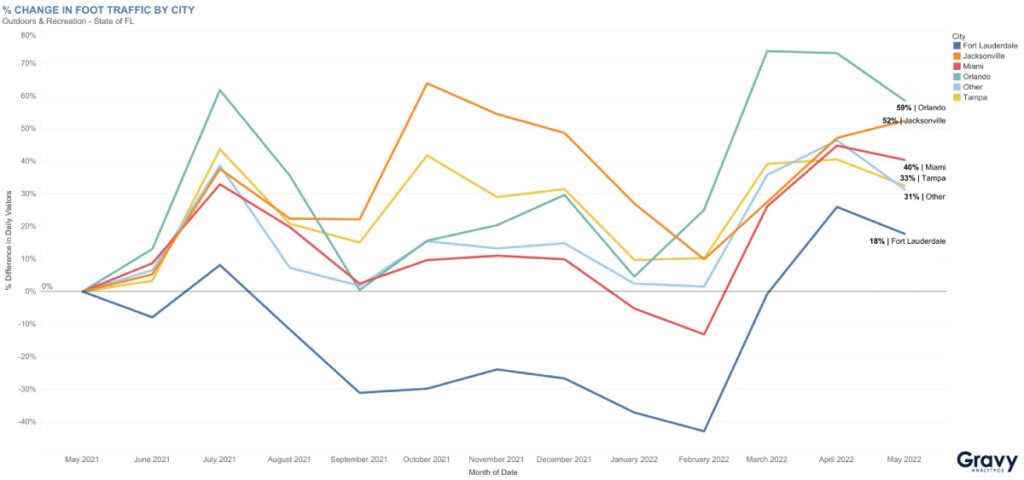
Restaurants
Inflation is more than likely affecting consumer dining and grocery shopping habits across the U.S. Based on our foot traffic data, it appears that consumer visits to restaurants in Florida reflect those national trends. Seasonality could also play a role in these fluctuations in dining behavior. Tourism during July 2021 and April 2022 provided cities like Miami with a boost in consumer foot traffic to restaurants and food stores. From August 2021 until February 2022, consumer foot traffic for all Florida cities was below May 2021 levels. In May 2022, Fort Lauderdale’s restaurant foot traffic was 19% lower, compared to May 2021.
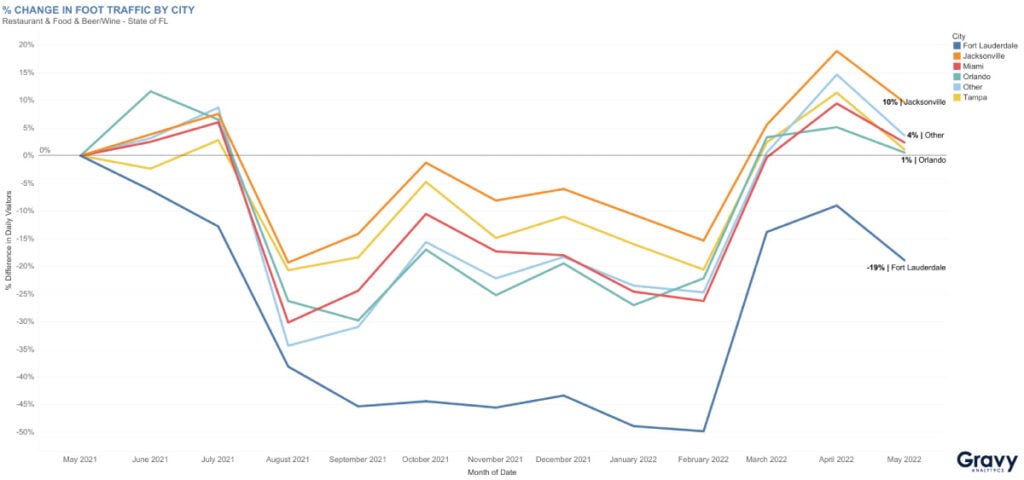
Shopping
Foot traffic to shopping destinations in most Florida cities saw foot traffic peak in July 2021 and then decline significantly during the later summer. After February 2021, shopping foot traffic increased again and peaked during Spring Break in April 2022. Year over year, Miami’s shopping foot traffic was 38% higher, which makes sense given its reputation as a shopping destination. Like Miami, Orlando and Jacksonville also saw increases in foot traffic to shopping destinations, compared to May 2021. Shopping foot traffic to Fort Lauderdale was flat in May 2022. Given the proximity of Miami and Fort Lauderdale, it’s plausible that Miami’s shopping areas are absorbing foot traffic from Fort Lauderdale’s malls and shopping complexes.
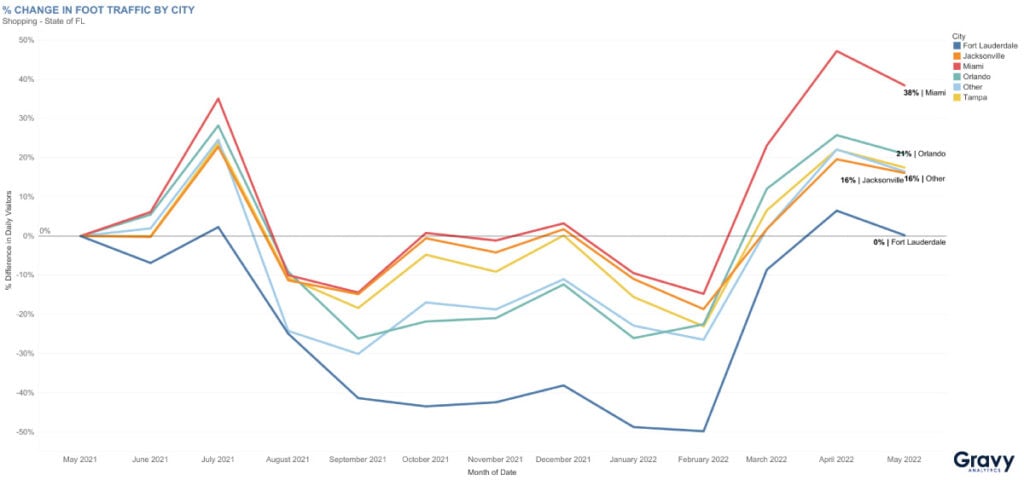
What Can Florida’s Economy Expect in the Future?
Consumer foot traffic data can provide states like Florida insight into how their economies are performing. Why is this important? The economy is always in flux and current factors like inflation are changing how consumers spend their money. Florida’s tourism industry is a big driving force in its economy. When location analytics are combined with other economic datasets, organizations can better understand how consumer foot traffic is affecting businesses in major cities across Florida. For more information on how organizations can use foot traffic data to understand consumer activity at city, regional, and national levels, contact one of our location intelligence experts today.




